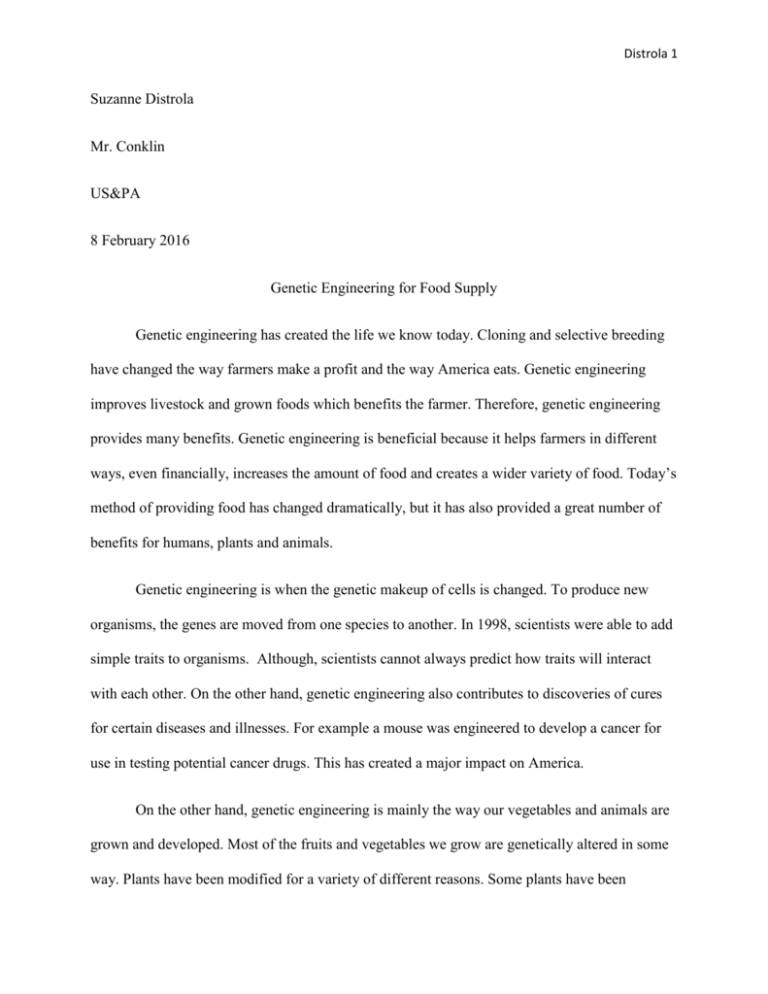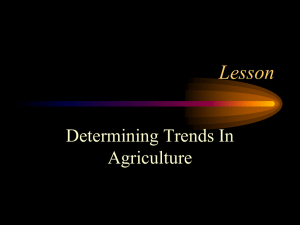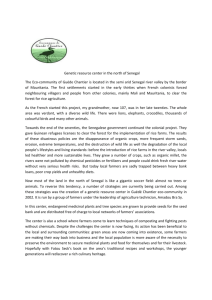Distrola Suzanne Distrola Mr. Conklin US&PA 21 May 2010 Genetic
advertisement

Distrola 1 Suzanne Distrola Mr. Conklin US&PA 8 February 2016 Genetic Engineering for Food Supply Genetic engineering has created the life we know today. Cloning and selective breeding have changed the way farmers make a profit and the way America eats. Genetic engineering improves livestock and grown foods which benefits the farmer. Therefore, genetic engineering provides many benefits. Genetic engineering is beneficial because it helps farmers in different ways, even financially, increases the amount of food and creates a wider variety of food. Today’s method of providing food has changed dramatically, but it has also provided a great number of benefits for humans, plants and animals. Genetic engineering is when the genetic makeup of cells is changed. To produce new organisms, the genes are moved from one species to another. In 1998, scientists were able to add simple traits to organisms. Although, scientists cannot always predict how traits will interact with each other. On the other hand, genetic engineering also contributes to discoveries of cures for certain diseases and illnesses. For example a mouse was engineered to develop a cancer for use in testing potential cancer drugs. This has created a major impact on America. On the other hand, genetic engineering is mainly the way our vegetables and animals are grown and developed. Most of the fruits and vegetables we grow are genetically altered in some way. Plants have been modified for a variety of different reasons. Some plants have been Distrola 2 modified so they can grow and survive in different climates and locations that they wouldn’t normally grow in. Other plants have been genetically modified so they produce their own pest repellant. Since genetic engineering can help protect and benefit the plants we are growing, farmers and manufacturers are saving money and making a greater profit. In addition, scientists have produced genetically altered seeds. These seeds are altered so they can survive in harsher conditions then they’re accustom. Therefore, more seeds are surviving and growing successfully. Since there are more seeds surviving, there is more food and produce that is harvested and sold. Genetically altering foods and animals has also made a variety of complications more tolerable. For example, manufacturers were losing large amounts of money because their produce was damaging easily and spoiling quickly. Tomatoes, for example, have been altered so they have tougher exteriors and stay fresher longer. Altering food has even benefitted the consumer! Japanese scientists have found a way to produce square watermelons, making it more convenient for the consumer to store the fruit. Since genetic modification has allowed plants to grow in climates and locations they couldn’t have before, this allows us to harvest the plants in many different locations instead of specific ones. This allows the food to grow in higher yield. The transfer of genes, which pass on the characteristic of greater yield, is extremely important. But it is also one of the most beneficial applications of genetic engineering in food. With earths growing issue of lacking fertile soil, genetic engineering has made it possible to grow plants in places they may not normally grow. Genetically engineering plants is greatly beneficial to farmers and manufacturers. Because of genetic engineering, plants can now survive in harsher climates and produce their Distrola 3 own natural pest repellant. Farmers use tons of chemical pesticides annually. Consumers do not want to eat food that has been treated with pesticides because of potential health hazards. Runoff of agricultural wastes from excessive use of pesticides and fertilizers can poison the water supply and cause harm to the environment. Growing genetically modified foods can help eliminate the application of chemical pesticides and reduce the cost of bringing a crop to market. Therefore, farmers won’t need to spray their produce. In addition, genetic engineering can be used to slow down the process of food spoilage which means the farmers also won’t lose any more money on spoiled food. The animals of today have also improved a great amount. Today’s animals have mostly been genetically engineered in some way. They’ve grown to satisfy the farmers with their physical traits. Farmers have used selective breeding to build an animal up to their satisfaction. For example, farmers are using selective breeding in their cows and livestock to create the best quality offspring. More meat and product means more profit. Now that the livestock has grown to satisfy the farmers, they are producing more to be sold for profit. Bulls are producing more meat, sheep are producing more wool, and diary cows are producing more milk. Genetic engineering has allowed us to replenish the food supply without the previous necessities. Plants are growing and surviving in climates and locations they wouldn’t normally. This allows us to grow more plants than we could before. Cross breeding and selective breeding also contribute to the wide variety of food we supply today. Using these methods of genetic engineering allows us to created better quality and more of a variety of foods. Genetically modifying foods has allowed us to create different types of certain foods also. For example, different kinds of apples, seedless watermelon, and yellow Distrola 4 watermelon are the results of genetic engineering. Manufacturers are also genetically engineering their fish and animals to satisfy consumers. Animals and fish are growing larger and more attractive to suit the consumers’ demands. In conclusion, genetic engineering has affected America in a variety of ways. The use of genetic engineering has allowed the farmers to expand and make a higher profit, it allows us to produce a higher yield of our product, and it allows us to produce a larger amount of different foods. The use of genetic engineering has made growing food more efficient because we are no longer restricted to growing our produce in specific locations. A larger number of plants are surviving and passing on the modified genes. Distrola 5 Works Cited BIO. “Plant Biotechnology.” Bio Science For Life. 21 May 2010. < http://bio.org/foodag/plants/> Shandilya, Anju.” Benefits of Genetic Engineering.”Intelligent life on the Web. <http://www.buzzle.com/articles/benefits-of-genetic-engineering.html> “Animal and Plant Genetic Engineering.”Looking at the Ethics of Technology for a New Millenninm. Church of Scotland. <http://www.srtp.org.uk/geneng2.htm#Applications>









